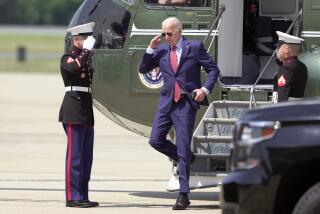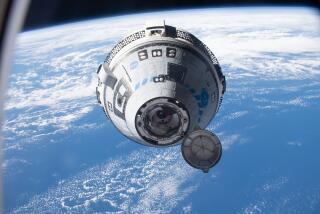New Shuttle Lofted on Mystery Mission
KENNEDY SPACE CENTER, Fla. — Atlantis joined America’s space shuttle fleet Thursday with a dazzling liftoff on a mission of mystery, carrying five astronauts and a pair of military satellites built to withstand nuclear radiation.
The sky was bright blue when Atlantis roared away from pad 39A at 8:15 a.m. PDT. Trailing fire and a column of white smoke, the shuttle arched eastward over the Atlantic and was visible from the ground for 4 1/2 minutes.
Sources reported that the launching had been set for 7:40 a.m. but was delayed 35 minutes until rain clouds moved out of the area. The mission is expected to last four or five days.
Except for the launching, which could be seen from much of central Florida, the flight was surrounded by as much secrecy as the Air Force could muster.
‘Crew Is Doing Well’
“The crew is doing well and all systems on board the orbiter are performing satisfactorily,” NASA’s Billie Deason said after the shuttle had been in orbit nearly five hours.
That was one of only two announcements scheduled during the flight. The other is to be a 24-hour notice that the shuttle will land at Edwards Air Force Base in California.
Officials gave no indication of when the satellites would be deployed, but it has been NASA’s policy to get payloads out of the cargo bay at the earliest opportunity, usually on the first day aloft.
Atlantis’ maiden flight, the 21st of the shuttle program, was the second all-Pentagon mission. A spy satellite was delivered to orbit by the shuttle Discovery on the first such flight in January.
Despite the news blackout, sources said the astronauts will deploy two Defense Satellite Communications System satellites, an advanced model known as DSCS-3. The $100-million satellites are designed to prevent an enemy from jamming their communications and for use by the President to send emergency instructions to nuclear forces around the globe.
Shielded From Radiation
Such satellites also have been shielded against the radiation and electromagnetic pulse effects of nuclear explosions, which could short out or overload unshielded electronic components. They are attached to the same rocket motor, which boosts them to a stationary orbit 22,300 miles high before they separate and are maneuvered to widely spaced stations.
The ship’s commander is Air Force Col. Karol Bobko, who has flown on two other shuttle missions. Other crew members are Air Force Lt. Col. Ronald Grabe, Army Lt. Col. Robert Stewart, Marine Maj. David Hilmers and Air Force Maj. William Pailes.
More to Read
Sign up for Essential California
The most important California stories and recommendations in your inbox every morning.
You may occasionally receive promotional content from the Los Angeles Times.










